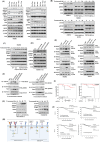PTPN9 regulates HER3 phosphorylation during trastuzumab treatment and loss of PTPN9 is a potential biomarker for trastuzumab resistance in HER2 positive breast cancer
- PMID: 39582148
- PMCID: PMC11758155
- DOI: 10.1002/cac2.12632
PTPN9 regulates HER3 phosphorylation during trastuzumab treatment and loss of PTPN9 is a potential biomarker for trastuzumab resistance in HER2 positive breast cancer
Conflict of interest statement
The authors declare no competing financial interests but the following competing non‐financial interests: Dr. Anthony Kong filed a patent of PTPN9 as a biomarker in relation to cancer treatment (international patent application No. PCT/GB2013/050057). However, this patent was not subsequently being maintained by further payments. All other authors declare no competing financial or non‐financial interests.
Figures

References
-
- Zhu JH, Chen R, Yi W, Cantin GT, Fearns C, Yang Y, et al. Protein tyrosine phosphatase PTPN13 negatively regulates Her2/ErbB2 malignant signaling. Oncogene. 2008;27(18):2525‐31. - PubMed
Publication types
Grants and funding
LinkOut - more resources
Full Text Sources
Research Materials
Miscellaneous

